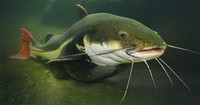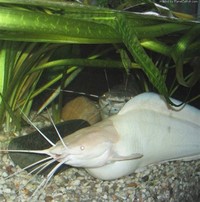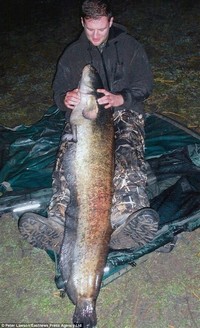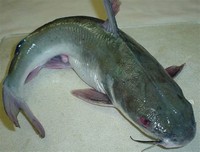Facts about Catfish

Tim Pruitt of Illinois caught the largest blue catfish, Ictalurus furcatus, in the Mississippi River on May 22, 2005 that weighed 56.25 kg (124 lb).

Mythology and literature record wels catfish of astounding proportions, but this has not been scientifically verified.

The flathead catfish can lay up to 100,000 eggs during one spawning cycle.

By using this system, catfish can locate their prey and find other catfish.

Catfish are very diverse, ranking second or third in diversity among orders of vertebrates, with almost 3,000 known species.

The back of the catfish's eyes are coated with a layer of crystals that reflect light allowing for excellent vision.

Some catfish species can inflict painful stings with their spines, such as the case with the stone and tadpole catfishes and the madtom.

Catfish also belong to the superorder Ostariophysi, which also includes the Cypriniformes, Characiformes, Gonorynchiformes, and Gymnotiformes (although some place Gymnotiformes as a sub-order of Siluriformes).

In catfish, a series of vertebral bones known as the Weberian apparatus, connect the swim bladder and inner ear.

In 2003, the U.S. Congress passed a law preventing the imported fish from being labeled as catfish.

The value of the catfish crop in the United States reached $425 million in 2003.

The dorsal fin of most catfish species technically has two spines, the first one very short.

Many species of catfish in the wild spawn once a year, with sexual maturity reached from three to five years.

Commercial catfish production generates over 46 percent of the value of aquaculture production in the United States.

The catfish’s lateral line can detect creatures at the surface, swimming through the water, or even walking along the shore.

A catfish’s hearing apparatus, which detect vibrations, is in its swim bladder, whereas the swim bladder on most fish is independent of the inner ear.

A very large wels catfish was caught by Kevin Maddocks on August 6, 1999, recorded at 91.62 kg (202 lb).

The Catalog of Fishes database lists 2,855 known species of catfishes.

Not all catfish families have prominent barbels; what defines a fish as being in the order Siluriformes are certain features of the skull and swimbladder.

Catfish belong to the phylum Chordata, subphylum Vertebrata, class Actinopterygii, order Siluriformes, and suborder Mematognathi..

The catfish, Corydoras arcuatus, is a good example of external tastebuds.

Other catfish commonly found in the aquarium trade are armored suckermouth catfish, banjo catfish, talking catfish, and long-whiskered catfish.

Catfish have well developed sensory organs, with many such organs covering their bodies.

Some recognize 37 families of catfish currently, although this number varies according to the taxonomic scheme.

Armored suckermouth catfish, released by aquarium hobbyists, has established wild populations in various warm waters around the world.

The largest flathead catfish, Pylodictis olivaris, ever caught was in Independence, Kansas, weighing 56 kg (123 lb 9 oz).

Nelson, in 1994, in his book Fishes of the World (third edition), listed 34 families of catfish, with about 412 genera and 2,405 species.

Catfish are found primarily in freshwater environments of all kinds, with species on every continent except Antarctica.

The wels catfish was introduced to Britain, Italy, Spain, Greece, and some other countries during the last century.

Catfish include bony-plated types and also smooth, naked types, but they do not have scales.

The madtoms of E North American streams have brightly colored patterns, but the majority of catfish are dull-colored.

The fish, mostly channel catfish and blue catfish, are found in most waterways in the region.

Siluriformes are monophyletic in their development of the upper jaw, which is able to move and support the catfishes barbels.

Several walking catfish (Clariidae) and shark catfish (Pangasiidae) species are heavily cultured in Africa and Asia.

Ictalurids are cultivated in North America (especially in the Deep South, with Mississippi being the largest domestic catfish producer).

Catfish are raised in warm climates, are inexpensive, and are safe food for the local grocers.

The most popular catfish in Florida is the channel fish; the second most desired is the white catfish.

Exports of one particular shark catfish species from Vietnam, Pangasius bocourti, has met with pressures from the U.S. catfish industry.

About one in every ten species of fish, and one in every 20 vertebrates, is a catfish.

Catfish, which have a sweet, mild flesh, are important as food fish throughout the world.

The Mekong giant catfish are not well studied and it is quite possible that they can grow even larger.

The channel catfish male builds the "nest" in mud banks along rivers, streams, lakes, or ponds.

Walking catfish has been introduced in the freshwaters of Florida, with these voracious catfish becoming a major alien pest there.
Unlike cats and dogs, whose whiskers are made of hair, catfish have special whisker-like feelers made of skin. These sensitive feelers are called “barbels." Each barbel is loaded with tiny taste buds and special olfactory sensors to help the fish smell.
Why is it called Catfishing? Toward the end of Catfish the documentary, the movie's protagonist Nev Schulman coins the term after talking to his personal catfish's husband, who used to be a fisherman. “They used to tank cod from Alaska all the way to China. They'd keep them in vats in the ship.Aug 23, 2013
Extant catfish species live inland or in coastal waters of every continent except Antarctica. Catfish have inhabited all continents at one time or another. Catfish are most diverse in tropical South America, Asia and Africa with one family native to North America and one family in Europe.
Some can be carnivores, herbivores, omnivores, or even limnivores (eating microorganisms within mud). A catfish's diet changes as it grows, with young catfish eating larvae and insects and mature catfish graduating to insects, snails, other fish and fish eggs.
Most of these secretive lights are nothing more than a ploy to catch fishermen and have little to do with actually attracting catfish. Night fishing with lights in or shining on the water is a pretty common practice for many species of fish. The lights draw in bugs and bait fish which in turns can draw in fish.
If chicken livers are the best known of all catfish baits, crawfish may be the most overlooked. All major species of catfish feed on crawfish, although most flatheads caught on craws weigh 20 pounds or less. Crawfish rank among the best baits of all for fishing in creeks and small rivers.Mar 19, 2014







